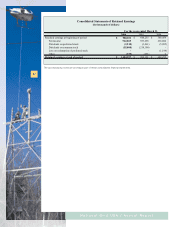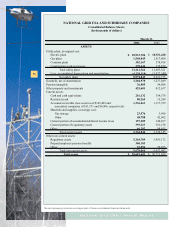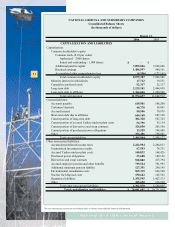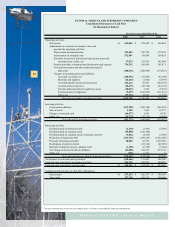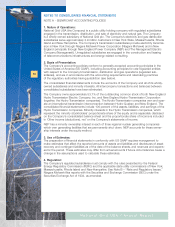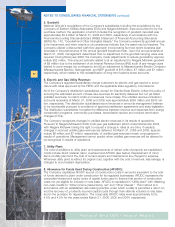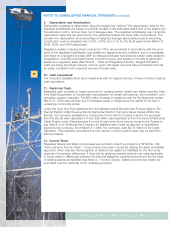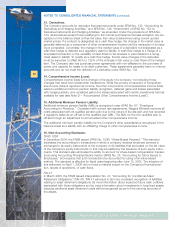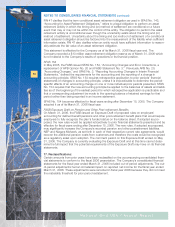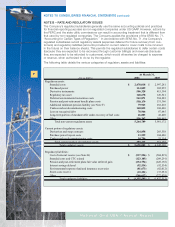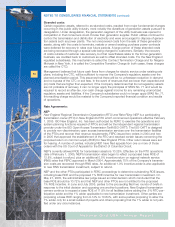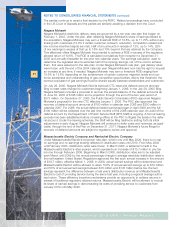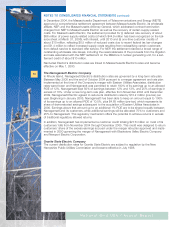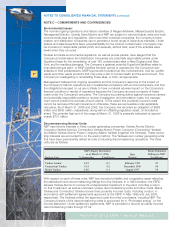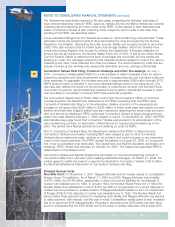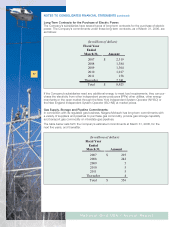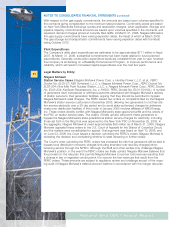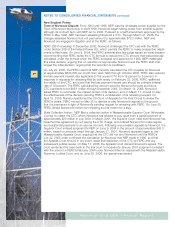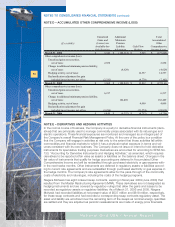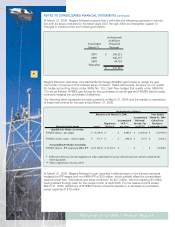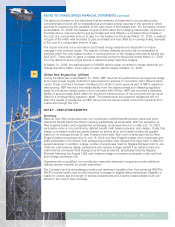National Grid 2006 Annual Report Download - page 42
Download and view the complete annual report
Please find page 42 of the 2006 National Grid annual report below. You can navigate through the pages in the report by either clicking on the pages listed below, or by using the keyword search tool below to find specific information within the annual report.
NOTES TO CONSOLIDATED FINANCIAL STATEMENTS (continued)
Stranded costs:
Certain regulatory assets, referred to as stranded costs, resulted from major fundamental changes
occurring in the public utility industry, most notably the divestiture of generation assets pursuant to
deregulation. Under deregulation, the generation segment of the utility business was opened to
competition in that consumers could choose their generation supplier. Public utilities continued to
control the transmission and distribution of electricity and were encouraged to dispose of genera-
tion assets such as power plants. The net unrecovered costs from the sale of these generation
assets, along with the costs to terminate, restate or amend existing purchase power contracts
were deferred for recovery in rates over future periods. A large portion of these stranded costs
are being recovered through a special rate being charged to customers. Similarly, the recovery
of costs outside of customer rate recovery, but that nevertheless relate to the former generation
business, are credited back to customers as well to offset stranded costs. For the New England
regulated subsidiaries, this mechanism is called the Contract Termination Charge and for Niagara
Mohawk in New York, it is called the Competitive Transition Charge (in both cases, these charges
are called the CTC).
Management believes that future cash flows from charges for electric service under existing rate
plans, including the CTC, will be sufficient to recover the Company’s regulatory assets over the
planned amortization period. This assumes that there will be no unforeseen reduction in demand
and no bypass of the CTC or exit fees. In the event of revenues that are lower than expected and
(or) costs that are higher than expected, if the Company determines that its net regulatory assets
are not probable of recovery, it can no longer apply the principles of SFAS No. 71 and would be
required to record an after-tax, non-cash charge against income for any remaining unamortized
regulatory assets and liabilities. If the Company’s subsidiaries could no longer apply SFAS No. 71,
the resulting charge would be material to the Company’s reported financial condition and results
of operations.
Rate Agreements:
NEP
New England Regional Transmission Organization (RTO) and Rate Filing: NEP is a participating
transmission owner (PTO) in New England’s RTO which commenced operations effective February
1, 2005. ISO New England, Inc. has been authorized by FERC to exercise the operations and
system planning functions required of RTOs and will be the independent regional transmission
provider under the ISO Open Access Transmission Tariff (ISO-OATT). The ISO-OATT is designed
to provide non-discriminatory open access transmission services over the transmission facilities
of the PTOs and recover their revenue requirements. FERC issued two orders in 2004 and two
in 2005 that approved the establishment of the RTO and resolved certain issues concerning the
proposed return on common equity (ROE) for New England PTOs. Other return issues were set
for hearing. A number of parties, including NEP, have filed appeals from one or more of those
orders with the US Court of Appeals for the District of Columbia Circuit.
NEP’s currently allowed ROE for transmission assets is 10.25%. Effective on the RTO operations
date of February 1, 2005, NEP’s transmission rates began to reflect a proposed base ROE of
12.8%, subject to refund, plus an additional 0.5% incentive return on regional network service
(RNS) rates that FERC approved in March 2004. Approximately 70% of the Company’s transmis-
sion costs are recovered through RNS rates. An additional 1.0% incentive adder is also applicable
to new RNS transmission investment, subject to refund.
NEP and the other PTOs participated in FERC proceedings to determine outstanding ROE issues,
including base ROE and the proposed 1% ROE incentive for new transmission investment. On
May 27, 2005, the administrative law judge issued an initial decision which concluded that the
base ROE should be 10.72% and that NEP and other PTOs are not entitled to the proposed
1% ROE incentive. In June and July 2005, parties to the proceeding filed two rounds of briefs in
response to the initial decision and opposing one another’s positions. New England transmission
owners continue to request a base ROE of 11.8% for all facilities before adding the .5% RTO par-
ticipation adder and the 1% adder applicable to new transmission investment. Other parties are
proposing a base ROE ranging from 9.14% to 10.64%, with some parties proposing to allow the
1% adder only for a small subset of projects and others proposing that the 1% adder is not justi-
fied under any circumstances.
42
National Grid USA / Annual Report


